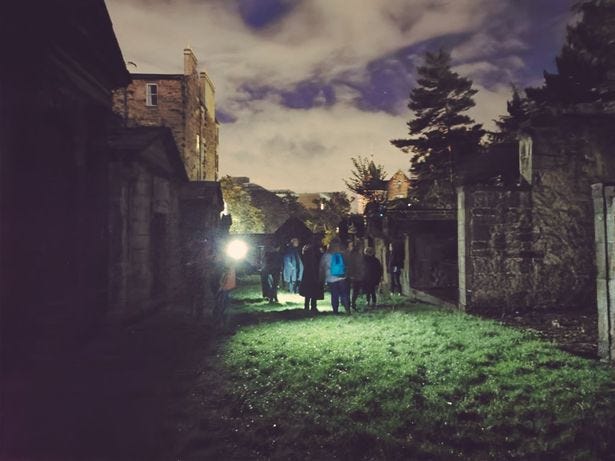When Ghost Stories Haunt Themselves
Why myth, memory, and mood matter more than we realise on haunted grounds
The story of Sarah Winchester is one that we can all learn important lessons from when it comes to how we contextualise historic biographical stories alongside contemporary ghost hunting activity.
The way in which Winchester’s legacy has forever been spookified by ghost tourism and media deeply fascinates me. It even led to the 2018 movie Winchester, starring Helen Mirren as the mysterious Sarah Winchester herself. If you have even a passing interest in ghosts, it’s likely you already know about the house that Sarah built.
The story of the Winchester Mystery House - and the woman said to haunt it while still alive - is deliciously gothic: a grieving heiress forever building, with carpenters on day and night shifts and new rooms blooming like mushrooms so the spirits of the dead could never quite find her. There are thirteen-paned windows and thirteen hooks and thirteen steps; a bell that tolls at midnight; a snug little séance room where, the tour guides whisper, Sarah took instructions from the spirits. There are staircases that rise to ceilings, doors that open onto sudden drops, and windows set into the middle of walls.
Winchester always wore black, slept in a different bedroom each night, they’ll tell you, and the whole house was a labyrinth designed to confuse the wandering souls of those killed by Winchester rifles - the guns her fortune was built on. It’s a brilliant story. Properly spooky enough to make your neck prickle… except that when you check the documents, almost none of it is true.
Winchester biographer Mary Jo Ignoffo attributes the ghostly stories to rumours likely “cooked up by journalists of her day.”1 The damage from the 1906 San Francisco earthquake is what left doors and staircases leading to nowhere and a need for construction - oddities that sit at the heart of so many spooky tales. That kind of lore can prime visitors: expectation and suggestion make ordinary features feel uncanny, and can lead to people having spooky experiences in the spooky environment.
The later myth of a guilty conscience, Ignoffo suggests, is also hard to believe. Few people felt guilty about guns at the turn of the 20th century - most people used them and saw them as a necessity. Those of us who imagine Sarah Winchester as a guilt-addled recluse may be seeing her through the lens of today’s complex relationship with firearms and gun death.

When I first dug into the Winchester story many years ago, what struck me wasn’t a “mad” heiress but a woman in mourning. Sarah Winchester had lost a child and a husband; she preferred dark clothing, used a private seance parlour to converse with spirits, and valued her privacy. It seems far more likely she was haunted by bereavement than by ghosts.
Of course, realism rarely stands in the way of a good tale. The film billed as “based on a true story,” the annual Halloween retellings, and the guided tours will keep the legend alive - and some visitors will leave certain they felt something or saw something ghostly in this mystery house. Stories are powerful that way.
However, what lingers about “weird” Sarah Winchester says as much about modern ghost belief as it does about her life. We like a spooky story we don’t have to interrogate too closely.
I felt this same tension years ago in Edinburgh’s Greyfriars Kirkyard, by the Covenanters’ Prison. Late one rainy August night, our ghost walk wound through the dark and, as our tour guide’s story reached a crescendo, an actor jumped from the shadows, shrieking on cue. It did exactly what it was meant to do - my heart raced, people clutched at one another, everyone laughed - and then I had a sobering jolt: we were playing at fear in a place marked by real suffering. The story was immersive, but the history asked for gentler hands.
In 1679, after the Battle of Bothwell Bridge, hundreds of Covenanters were penned there in the open for months; many died, others were executed, or deported. That history underpins the tale of the Mackenzie Poltergeist - often billed today as “Europe’s most violent poltergeist.” This, it is said, is the ghost of Sir George Mackenzie, the man who condemned the prisoners to their fate. We talk plenty about the monster in the story - because, as a poltergeist, he attacks tourists and visitors. But we speak far less about the people he made suffer while still alive. A different (and real) kind of monstrous.
That’s what stories like Winchester or Mackenzie reveal: how haunted lore can outgrow the history underneath it. Many of these tales are rooted in real loss, suffering, and hardship, later shaped to suit contemporary tastes. A little care - about sources, tone, and context - goes a long way, especially in places tied to difficult pasts.
A compelling legend can become the scaffolding for “evidence.” That doesn’t make anyone gullible - it just shows how powerful stories are. But it does mean that before we treat lore as data, we should separate the history from the tourism, and notice how suggestion shapes our experiences.
If you’re heading into a haunted site with a historical story attached, ask three simple questions:
Which parts of this tale are documented history, and which are tour-script lore?
What here might be stagecraft, mood, or expectation at work?
Am I treating someone’s tragedy with dignity while I investigate?
If your answers stay honest, your methods will too. It doesn’t mean you can’t enjoy ghost stories - but this is a way to enjoy them responsibly, while honouring the dead.
This Horror Movie Is Based on a True Story. Sort Of, Robert Ito, The New York Times





It would be have been awesome to walk around the Winchester House before the 1906 earthquake.